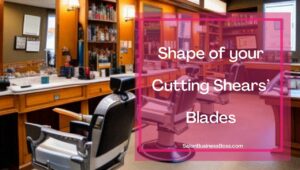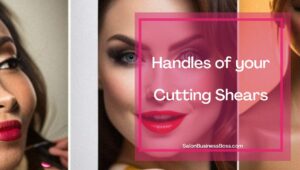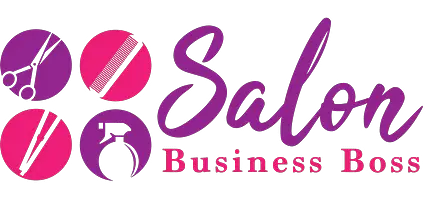All professionals have a set of tools that are essential to their careers. Hair stylists are not any different. Without cutting shears, a hair stylist cannot begin to perform their magic. Hair cutting shears can be costly; therefore, it is important to invest wisely.
Choosing the right hair cutting shears is a personal choice for each stylist. It requires selecting the correct size, the shape of the scissors, types of handles that fit them and that best match the types of cuts they use daily. Using hair cutting shears that meet the demands of the work you perform will create satisfied customers.
Purchasing and using the right scissors for the task is essential to optimize your time and ability as a stylist. Additionally, the proper pair of styling shears reduces the potential for wrist and hand pain from overuse. Continue reading for factors to consider before investing in your career’s tools.
Size of your Cutting Shears
Scissors are measured in inches. To determine the size of a pair of cutting shears, place the ruler or tape measure at the tip of the blades to the end of the handle. For your comfort, selecting the length of your shears, it is best to try the scissors. You use them for hours, so it is imperative that they feel right to you. Do not force a fit.
Once you are set on the fit of your shears, the use of your scissors is your next consideration. The length of your styling shears will produce different styles and haircuts. Most stylists utilize shorter length shears for more precision. Smaller scissors are also used for finishing touches. Most methods used by stylists can be successfully accomplished with shears between 5.5 and 6.0 inches.
To cut sections of hair for trims and/or using a comb, a longer scissor is recommended. Typically, the grouping of longer scissors begins at the 6-inch delineation. Barbers tend to use longer shears because of the techniques they employ. Longer blades, 6.5 to 7.0 inches allows barbers to do their best work.
Shape of your Cutting Shears’ Blades

Convex, semi-convex, and beveled edges are the three types of blades that you will most frequently find available in styling shears. Your experience and the types of cuts you focus on should be factors thought about during your decision-making process.
-
Convex Edge Blades
These blades have extremely sharp edges. The sharpness of the edge provides power to the shear. Convex blades are suited for very detailed cuts. When you need precision in the style, this blade will provide that exactness. Because of the honing of the blades, these shears will necessitate following the maintenance steps detailed by the manufacturer.
-
Beveled Edge Blades
Beveled edge blades have been used by stylists for longer than other blades. They are also the most affordable blades. Due to both of these factors, beveled edge blades are considered the best option for those just beginning their careers as stylists.
The construction of this blade makes it more durable than others. Since it has a thicker blade, it does require more force than the extremely sharp convex blades. Beveled edges also have micro-serrations on either or both sides of the blade. These grooves keep hair from slipping along the blade.
While many recommend this for newer stylists, many seasoned professionals have this blade in their toolbox. It works well for detailed cuts. You can style effectively with the beveled edge especially if your shears are of a higher quality.
-
Semi-Convex Edge Blades
A fusion of the convex blade and the beveled edge blades creates the semi-convex blades. The edges of these blades are not as thick as the beveled edge blades. Nor are these blades as super sharp as the convex blades can be. They do offer you a narrower edge than a beveled edge, but they are not an authentic convex edge.
As a hybrid in design, these shears are also a blend of pricing. They are not as costly as convex blades. However, these blades will cost more than the beveled edge blades. For their value, they will allow a broader repertoire of styles that you can create using these blades. Durability is another plus for these shears.
What equipment do you need to start a salon business?
Handles of your Cutting Shears

Ergonomics needs be considered in many aspects of a hairstylist’s day. Exploring options on the handles of your cutting shears is one means to reduce the fatigue that is a part of overusing your hands. Tired hands can cause you to make mistakes when styling, which will create concerns with your customers.
Stylists repeat motions frequently, which can cause issues with their hands, wrists, and arms. Trying different handles can reduce the effects of repetitive motion. The handles you use should allow for smooth and effortless motions.
-
Level Handles
Level handles are the available handles on all types of scissors. As the name implies, both handles are directly across from each other. Additionally, both handles are of the same size. Also referred to as straight or opposing handles, these are effective for stylists who use their middle finger and thumb when cutting.
However, to style with these, you need to raise your elbow for the correct angle. Doing this causes fatigue and stress on your hands, arm, and shoulder. With the strain this style causes and now that there are other options, level handles are not recommended.
-
Offset Handles
In offset handles, the finger and thumb handles are not directly across from each other. These two handles are designed to be angled from each other. The thumb handle is shorter. Therefore, your thumb does not need to overreach. Your hand is more relaxed and open.
The intent is to offer a more ergonomic means of manipulating your styling shears. Because they are designed to be more natural for your hands to use, they will reduce the tiredness associated with hairstyling.
Since your hands will not be as fatigued, you can cut with more efficiency. Also, your hand movements will be agile, which allows you to control your movements. This provides a better hair styling experience for your customers.
-
Crane-shaped Handles
The crane-shaped handles are considered one of your most ergonomic selections. Its design has one longer handle and an angled thumb handle. With the design, your elbow can be lower, which reduces the stress on your wrist, arm, and shoulder. Since this design lessens the strain on your body, it allows you to focus your energy on styling.
Crane-shaped handles are recommended to alleviate potential injuries.
Related Questions

Can you style hair with dull shears?
Hair can be cut with dull shears, but not well. Hair is torn instead of cut when you use dull blades. Your customer will end up with an uneven cut if you use dull scissors. Cuts performed with dull blades will result in fray and rough edges.
How do you sharpen scissors?
The manufacturer of your styling shears will typically offer a service to sharpen your blades. You will usually receive the best performance from the manufacturer. If that is not available, there are professionals who will sharpen the blades on your styling shears. You can learn how to sharpen the blades yourself, but you will need special equipment and training.
How often do scissors need to be sharpened?
At a minimum, cutting shears should be sharpened annually. However, depending upon the type of work you do, the quality of your shears, and the number of cuts you perform, you may need to the blades sharpened more frequently.
Looking to start your own Salon? Get the documents you need to get organized and funded here.
Please note: This blog post is for educational purposes only and does not constitute legal advice. Please consult a legal expert to address your specific needs.

About the author. Entrepreneur and Salon Business Fan.
Hi! I am Shawn and I am a happy individual who happens to be an entrepreneur. I have owned several types of businesses in my life from a coffee shop to an import and export business to an online review business plus a few more and now I create online salon business resources for those interested in starting new ventures. It’s demanding work but I love it. I do it for those passionate about their business and their goals. That’s why when I meet a salon business owner, I see myself. I know how hard the struggle is to retain clients, find good employees and keep the business growing all while trying to stay competitive.
That’s why I created Salon Business Boss: I want to help salon business owners like you build a thriving business that brings you endless joy and supports your ideal lifestyle.

